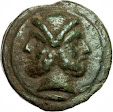One Quarter of a Circular Shaped Bronze Ingot
The piece weighs 1443 grams, or about 5 roman pounds.
The seller had four cast bronze pieces. This was my favorite of the group. The broken ax looked interesting, and did not sell, but this chewed up my budget for the month.
The vendor's description - AES PREMONETALE. Aes Formatum.
A Quarter of a large circular cake-shaped bronze ingot. Central Italy, 6th-4th century BC., RRR
Cf. Garrucci, TAV III, 4 and 5, from the Cere hoard (of about the same shape and weight).
1443 g
152 x 97 x 39 m
Untouched earthy green patina. EF.
This very rare and fascinating example has the weight of an Aes Signatum or Five Roman Pounds and probably represents a quincussis.
Garrucci, page 3; five pieces are shown on plate III.
I translated the text from Garrucci:
first I broke the Italian into sections to help google translate group the words -
· Di piu perche vi si vede chiaramente come il metallo si e aperta la via intorno intorno per un fondo che doveva percio essere mobile.
· Il primo pezzo due libbre e once due
· once due
· il secondo due libbre once otto
· il terzo libbre quattro once otto e mezzo
· mezzo
· otto
· il quarto libbre quattro once tre
· il quinto libbre quattro once otto e mezzo
The English, tho I am not sure of all the translations are right. -
· Most of all, as you can see clearly how the metal opened up the street around for a base that had to be mobile.
· The first piece two pounds and two ounces
· Once two
· The second two pounds eight ounces
· The third pound four times eight and a half
· half
· eight
· The fourth pound four times three
· The fifth pound four times eight and a half
Roman
Republic or Central Italian, Aes Formatum
Latium,
Anonymous, VIII-IV century BC
Parte
di pane o torta quadrilateral (part of a larger plate).
Haeberlin
tav.II n.7.
BB;
388 grams; 54 mm X 52 mm 24.9 mm
The older piece is shown below with two Ramo Secco bars and an unmarked bar.
top left, 744 grams - top right, 375 grams
bottom left, 854 grams - bottom right, 892 grams
Note the seams are obvious on the three bars, but not on the broken plates.
Roman
Republic, Aes Rude, Central Italy
9th
to 5th century BC
375
grams, 60 X 55 X 22 mm
Patina
verde
I will attach a few side views of the smaller pieces later. You can see the flat spot where the molten metal must have hit a "wall" and stopped flowing. The rest of the sides are brittle fractures where the flat plate was broken. I think I can see what looks like a chisel mark that helped start the breaks. The new piece looks like it has a sand bottom and cooling metal "smooth" top.
I took some pictures today of the three pieces. The top pic shows "smooth" parts of the bronze plate where I think it stopped flowing when it hit a wall. The second picture shows jagged, brittle fracture. The next picture shows the two partial plates. The right one is my most recent. I had to buy a larger scale.
375 grams 388 grams
1442 grams for the cake on left









